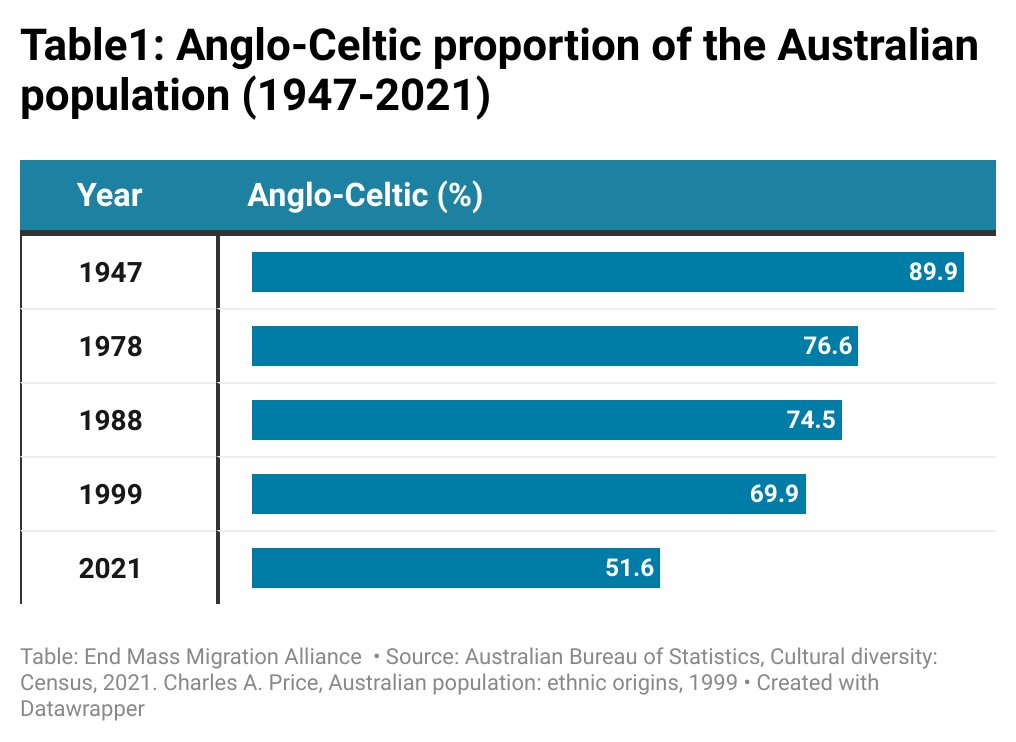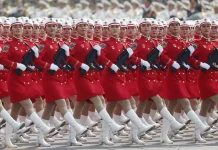
In Tucker Carlson’s interview with Matt Benz, Benz noted that “NATO was publishing white papers saying that the biggest threat NATO faces is not actually a military invasion from Russia. It’s losing domestic elections across Europe to all these right-wing populist groups” whose anti-EU policies raised the spectre that “the EU would come apart, so NATO would be killed without a single bullet being fired.”
It begs the question: What is the point of having a military alliance to defend your people, when its survival depends on the genocide via mass immigration of the people it is supposed to defend?
One local example of this inversion of the word “defence” is a July 2020 paper published by the ANU’s Strategic and Defence Studies Centre, titled How to Mobilise Australia. Aside from demonstrating that conscription has long been on the ADF’s contingency list, it echoes NATO’s anxieties:
“Future national mobilisations will again need to call on the people for support. Unlike during World War One however, the marshalling of the Australian people may be contested not just from within but also from without. Foreign powers might now try to deliberately prevent national mobilisation by meddling in Australian society using digital technology. Australians are now closely linked to others around the globe exchanging words, data, images and videos at near-real time. Last century’s distinctions between the domestic and the international have vanished.
“This shift to a more contested social environment reflects a revitalised appreciation of the importance of a nation’s societies to the nation’s ability to defend itself. The ‘people’ are now becoming reconceptualised as a centre of gravity that may be exploited by others to win future conflicts, potentially without any fighting at all. An adversary may now seek to mobilise Australians for their own purposes.”
This is code for “if the Australian people get fed up with mass immigration and Anglophobic propaganda they will refuse to fight for us, so we’d better blame populism on Russia and China.”
It’s evil.
As reported by The XYZ, said mass replacement immigration and Anglophobic propaganda has indeed hamstrung recruitment targets for globohomo militaries, including the ADF. The government’s solution to a problem of its own making is to double down on the cause:
“Australia cannot ignore the possibility of a conflict before these technologies are fully developed and must consider the most abundant, proven and effective resource available to us – human resources.
“Humans have significantly more autonomy and versatility than robotics and can be supplied and taught with far less investment and time. They also have the benefit of operating truly autonomously. One important restriction is supply. ADF predictions are that only 13% of the recruiting demographic of 17-24-year-old Australians are eligible and have propensity for military service, equating to 350,000 people annually. However, these Australians are also sought after by emergency services, professional private employment streams and other government service.
“The normal model to access large numbers of human resources is conscription, where multiple approaches exist, from the ongoing United States plan to reintroduce a national draft system under the Selective Service System to the compulsory military service of the Republic of Korea. However, this has always been a politically sensitive subject in Australia – the five times conscription has been introduced have resulted in significant domestic opposition. There are two alternative methods to access human resources in a mobilisation or scaling plan that could be considered.
“The first option is based on immigration and collective security in the region. Australia as a nation has benefited greatly from immigration. It allows the country to maintain growth rates and it brings a diversity of experience and culture to Australia. These benefits extend to national security – for example, Australia regularly allows foreign officers to transfer laterally into the ADF. Whilst it might be worth discussing a direct trade of citizenship for military service, it may be more useful to draw on the Commonwealth model used by the United Kingdom. There are currently between 1800 and 2000 Fijian soldiers serving within the British Armed Forces. These forces provide significant remittances back to Fiji and are a source of pride to the Fijian Government.
“Given the obvious wisdom of Australia refocusing its attention on South Pacific friends and allies, offering the opportunity for citizens of these countries to serve within the ADF would be a simple first step to expanding forces. The logical expansion of this would be to offer citizenship or permanent residency following a specified period of service.”
So we’re talking foreign mercenaries, and mass importing millions of Asians in the hope they will join the ADF to fight against Asians. How’d that work out for the Romans?
Let’s examine how we got here:
- After Australia narrowly avoided invasion by an Asian power during WWII, the government adopted the policy of “populate or perish”, ie mass immigration.
- It proceeded to import millions of Asians.
- It gave our industry to China in the belief that free trade would liberalise China.
- China became an industrial and military powerhouse.
- Australia filled up with Chinese people who generally do not assimilate, instead colonising entire suburbs while actively lobbying on behalf of their own ethnic interests and strengthening ties to their homeland.
- Native Anglo Australians were demonised as “racist” and pushed to the point of minority status via mass immigration.
 Several generations of strategic blunders have led Australia to the point where we lack the industrial capacity to maintain a war of attrition of the kind being waged in the Ukraine, and a sizeable proportion of our fighting age indigenous Anglo population would prefer to join communities which advocate for our own interests rather than fight for a government which despises us.
Several generations of strategic blunders have led Australia to the point where we lack the industrial capacity to maintain a war of attrition of the kind being waged in the Ukraine, and a sizeable proportion of our fighting age indigenous Anglo population would prefer to join communities which advocate for our own interests rather than fight for a government which despises us.
From this catastrophic starting position, the Australian government is now trying to pick a fight in a war of attrition.
The irony is that Australia could have had a massive Anglo population had the White Australia Policy been maintained, and Christianity remained at the heart of our identity.
Whites building a family through generations….Imagine if this was every white family…. pic.twitter.com/aSXgb8MUBL
— Darren aka Dazz 14:88 (@AntiKalergiPlan) February 29, 2024
With 80 years of high birthrates Australia could well have been a military powerhouse, but we traded it all for sex, drugs, rock ’n’ roll, spicy food, and the redefinition of baby murder as “women’s empowerment”.
This is the denial at the heart of Australia’s defence strategy. Nobody will fight for the Australian State, even if conscripted. There is no national interest because the Australian State is no longer a nation, but merely an economic zone.










